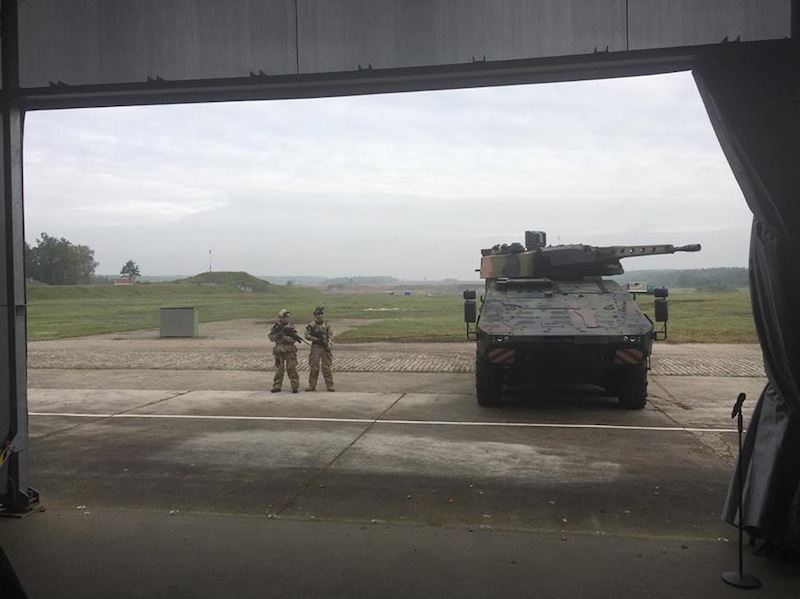Hol Dir den wöchentlichen SPARTANAT-Newsletter.
Dein Bonus: das gratis E-Book von SPARTANAT.
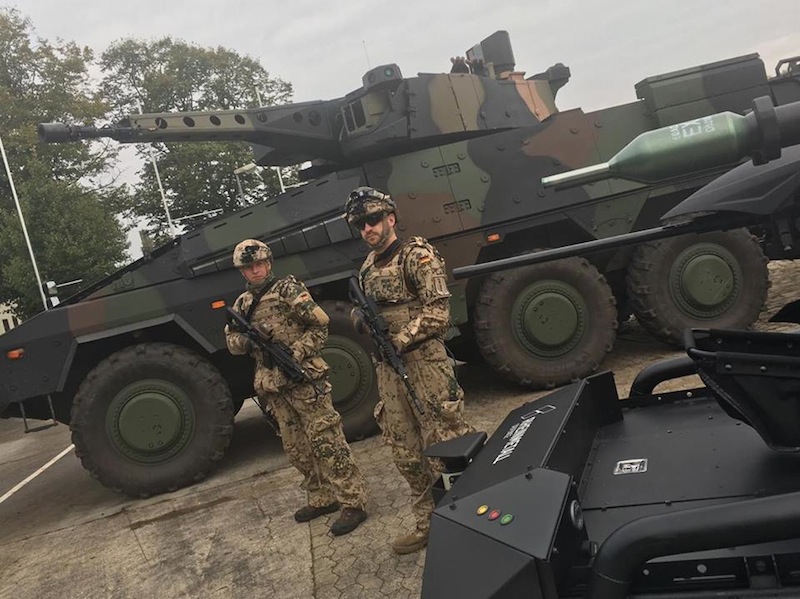
PRÄSENTATION: System Infanterie – vernetzt ins Gefecht
Auf der Tribüne hat man die Wahl: Sicht auf den Bildschirm und Computerspiel-Ästhetik. Oder doch einen Blick in die Landschaft schweifen lassen: da ist sie dann, die Realität ohne Virtualität.
Auf der Tribüne hat man die Wahl: Sicht auf den Bildschirm und Computerspiel-Ästhetik. Oder doch einen Blick in die Landschaft schweifen lassen: da ist sie dann, die Realität ohne Virtualität. Wer hier den Überblick verliert, die Kamera der Drohne von oben lässt als dritte Möglichkeit eine gute Beobachtung zu. Rheinmetall Defence präsentiert in im norddeutschen, firmeneigenen Erprobungsgelände Unterlüß der sein „System Infanterie“. Wir von SPARTANAT können uns hier die neuesten Entwicklungen hautnah anschauen.
Das vorgeführte Szenario heißt „Aufklärung“: ein GTK Boxer mit LANCE Turm bringt die Soldaten in den Einsatzraum, wo sie absitzen und weiter Aufklären gegen ein symbolisches Dorf, wo eine IED Werkstatt vermutet wird.  Am Bildschirm bewegt sich das Fahrzeugsymbol durch eine Karte, die wie Google Earth ausschaut, dann die blauen Symbole für die abgesessenen Grenadiere dazu. Sie tragen die IdZ-ES Ausrüstung und sind mit dem Mutterschiff vernetzt. Als sie beim Aufklären auf einen vermeitlichen Feind stoßen, ergänzen sie das Symbol für den Feind. Der Boxer stößt nach, seine beeindruckende 30mm Kanone bleibt stabil dorthin gerichtet, wo der Feind vermutet wird und sich vielleicht für einen Gegenstoß rüstet.
Am Bildschirm bewegt sich das Fahrzeugsymbol durch eine Karte, die wie Google Earth ausschaut, dann die blauen Symbole für die abgesessenen Grenadiere dazu. Sie tragen die IdZ-ES Ausrüstung und sind mit dem Mutterschiff vernetzt. Als sie beim Aufklären auf einen vermeitlichen Feind stoßen, ergänzen sie das Symbol für den Feind. Der Boxer stößt nach, seine beeindruckende 30mm Kanone bleibt stabil dorthin gerichtet, wo der Feind vermutet wird und sich vielleicht für einen Gegenstoß rüstet.
Sinn und Zweck der Demonstration: Rheinmetalls „System Infanterie“ steigert die Kampfkraft der abgesessenen Kräfte in Verbindung mit unbemannten Systemen und unterstützenden Feuerkomponenten erheblich. Im Zentrum des Systems steht der Infanterist. Er übernimmt auch in den auf die neuen Einsatzszenarien ausgerichteten Landstreitkräften eine zentrale Funktion. Der Infanterist muss sich im hochmobilen, hauptsächlich abgesessenen Einsatz in schwierigem, unübersichtlichem Gelände und meist auch im urbanen Umfeld bewegen – teilweise in extremen klimatischen Bedingungen. Er ist einer Vielzahl von Bedrohungen ausgesetzt und muss sich gegen symmetrisch und auch asymmetrisch operierende Gegner mit der angemessenen Intensität durchsetzen können.
Soldaten, Fahrzeuge und Drohnen sind miteinander vernetzt. Die korrekten Daten helfen bei der schnellen Entscheidungsfindung.
Rheinmetalls „System Infanterie“ vernetzt die Soldaten, ihre Sensoren und Effektoren einschließlich ihrer unbemannten Systeme und Fahrzeuge zu hoch wirksamen Gefechtsverbunden, schafft ein einheitliches Lagebild und bindet die einzelnen Komponenten in die vernetzte Operationsführung ein. Das System ist für den infanteristischen Einsatz in schwierigem Gelände einschließlich des Kampfes im bebauten Gelände ausgelegt.
Rheinmetalls „System Infanterie“ umfasst unter anderem folgende Systeme und Komponenten:
Soldatensystem IDZ-ES und Führungssystem TacNet: „Infanterist der Zukunft – Erweitertes System (IdZ-ES)“ ist das derzeit modernste in Nutzung befindliche Soldatensystem. Die modulare Kampfausstattung bewährt sich seit 2013 im Einsatz. Der IdZ-ES mit seinem Führungssystem TacNet bildet das Herzstück des „Systems Infanterie“. Die flexible Einbindung weiterer Sensoren, Effektoren oder Plattformen ist jederzeit möglich. In Unterlueß kann man sehen, wie sich das System effizient weiterentwicklet hat. Der Rückrechner ist kleiner geworden, Plattenträger und Gefechtsgürtel sind verbunden, um den Rücken des Soldaten zu entlasten. Das System wirkt auch unter Einsatzbedingungen praktikabel.
Die modulare Kampfausstattung „Infanterist der Zukunft – Erweitertes System“ bindet die abgesessen operierenden Soldaten in die vernetzte Operationsführung ein. Als „boots on the ground“ entdecken, erkennen und identifizieren sie Ziele und bekämpfen sie – entweder durch ihre eigenen Kampfmittel oder durch andere Effektoren des Verbundes Aufklärung-Führung-Wirkung. Die schnelle, präzise, angemessene Bekämpfung von Zielen trägt somit nicht nur zum Schutz eigener Kräfte, sondern auch zum Schutz der Bevölkerung und zur Vermeidung von Kollateralschäden bei.
Und das mit Praxiserfahrung; Seit Sommer 2013 befindet sich IdZ-ES im Einsatz in Afghanistan. Und in immer größrerer Zahl: Die Bundeswehr hat seit 2012 in drei Losen insgesamt 90 Systeme zur Ausstattung für jeweils eine Zehn-Mann-Gruppe beschafft. Bei der jetzigen Beauftragung steht der Zug im Mittelpunkt der Betrachtung. Mit den 68 Zugsystemen lassen sich über 2.460 Soldaten ausrüsten. IdZ-ES integriert als ganzheitlicher Systemansatz das „Gesamtsystem Infanterie“ – den Infanterie- bzw. Panzergrenadierzug mit ihren Fahrzeugen und den darin verbauten Basisstationen – in die vernetzte Operationsführung.
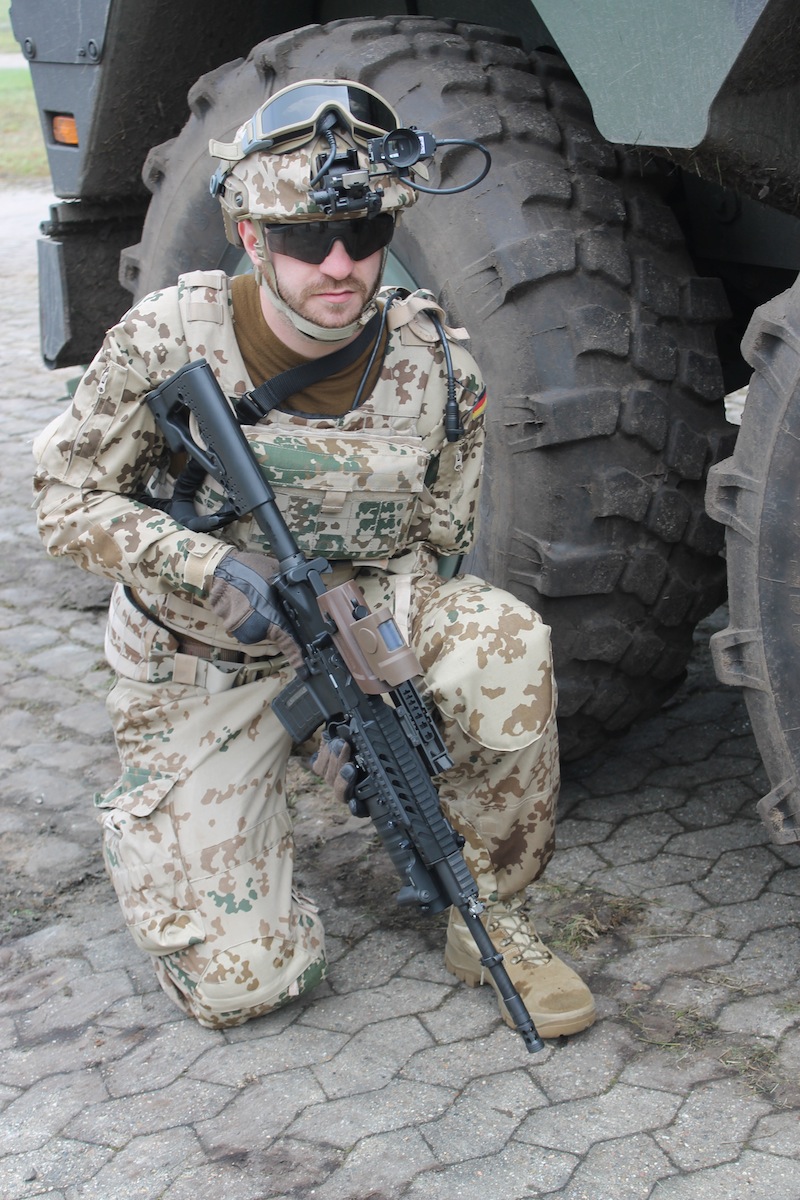 Besonders hervorzuheben ist das Kern- und Helmsystem. Der über einen Akkupack mit Energie versorgte Kernrechner – beides wird auf dem Rücken getragen („Elektronischer Rücken“) – steuert über diverse Schnittstellen alle Geräte und Sensoren, die der Soldat mitführt. Zu den Hauptfunktionen zählen Stromversorgungsmanagement, Zugangskontrolle und -überwachung, Informationssystem Soldat zur Karte/Lagedarstellung, Navigation, Meldewesen, Austausch von Aufklärungs- und Zieldaten, Verarbeitung diverser Sensordaten (z. B. Eigenposition, Blickrichtung), Bedienerschnittstelle und Visualisierung sowie die Systemkonfiguration. Das sind verdammt viele Informationen, die gleichzeitig präsent sind und strukturiert werden wollen, damit hier niemand den Überblick verliert. Der IdZ-ES bewirkt das Gegenteil: einen guten Informationsfluss und eine schnellere Entscheidungen, eben durch mehr korrekte Information.
Besonders hervorzuheben ist das Kern- und Helmsystem. Der über einen Akkupack mit Energie versorgte Kernrechner – beides wird auf dem Rücken getragen („Elektronischer Rücken“) – steuert über diverse Schnittstellen alle Geräte und Sensoren, die der Soldat mitführt. Zu den Hauptfunktionen zählen Stromversorgungsmanagement, Zugangskontrolle und -überwachung, Informationssystem Soldat zur Karte/Lagedarstellung, Navigation, Meldewesen, Austausch von Aufklärungs- und Zieldaten, Verarbeitung diverser Sensordaten (z. B. Eigenposition, Blickrichtung), Bedienerschnittstelle und Visualisierung sowie die Systemkonfiguration. Das sind verdammt viele Informationen, die gleichzeitig präsent sind und strukturiert werden wollen, damit hier niemand den Überblick verliert. Der IdZ-ES bewirkt das Gegenteil: einen guten Informationsfluss und eine schnellere Entscheidungen, eben durch mehr korrekte Information. 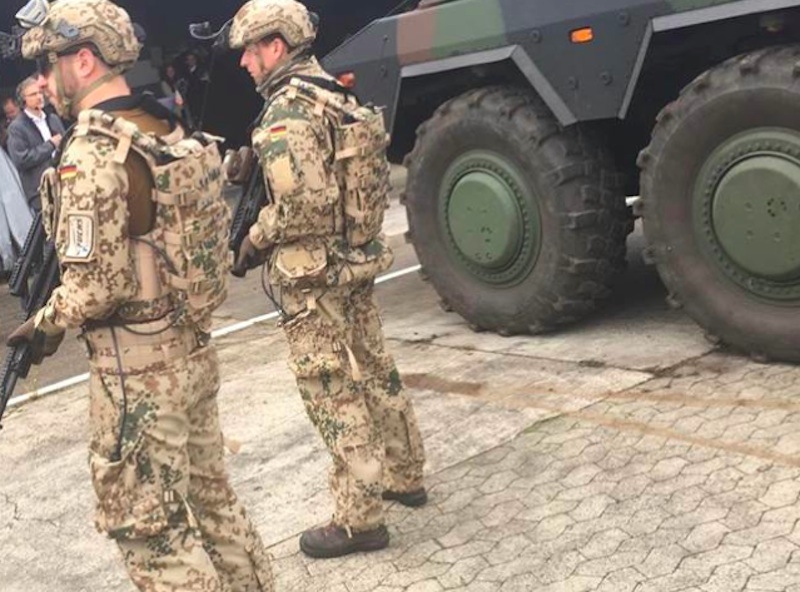 Und so funktioniert das am Mann: Über eine manuelle Bedieneinheit (BAG = Bedien- und Anzeigegerät) kann der Soldat das Soldatenführungssystem und die Kommunikation steuern. Auf dem BAG oder alternativ seinem OLED-Helmdisplay kann er alle relevanten Daten zur Lage, der Position eigener Kräfte (blue force tracking), zum Auftrag und zum Systemstatus erkennen. Die modular aufgebaute Bekleidung lässt sich an die geforderten Umwelt- und Temperaturbereiche optimal anpassen. Dazu kommt eine ballistische Unterziehschutzweste (Schutzklasse 1) mit integriertem Lüftungsshirt sowie die modulare Trageausstattung, die Munition, Kampfmittel, elektronischen Rücken und zusätzliche Ausrüstung aufnimmt. Die Schutzweste IdZ-ES ist als Komplettweste mit Chestrig (Brusttragesatz) und Hüftgurt konzipiert und nimmt verschiedene Schutzeinschübe auf, so dass der Schutz der deutschen Schutzklasse 4 entspricht. Der Gruppenführer und sein Stellvertreter erhalten die Führerzusatzausstattung, die aus dem tragbaren Führungsrechner besteht. An den Handwaffen befinden sich drahtlose Push-to-Talk-Tasten, die es ermöglichen, mit angeschlagener Waffe zu funken. Zudem lassen sich an den Handwaffen optische und optronische Anbaugeräte aufnehmen.
Und so funktioniert das am Mann: Über eine manuelle Bedieneinheit (BAG = Bedien- und Anzeigegerät) kann der Soldat das Soldatenführungssystem und die Kommunikation steuern. Auf dem BAG oder alternativ seinem OLED-Helmdisplay kann er alle relevanten Daten zur Lage, der Position eigener Kräfte (blue force tracking), zum Auftrag und zum Systemstatus erkennen. Die modular aufgebaute Bekleidung lässt sich an die geforderten Umwelt- und Temperaturbereiche optimal anpassen. Dazu kommt eine ballistische Unterziehschutzweste (Schutzklasse 1) mit integriertem Lüftungsshirt sowie die modulare Trageausstattung, die Munition, Kampfmittel, elektronischen Rücken und zusätzliche Ausrüstung aufnimmt. Die Schutzweste IdZ-ES ist als Komplettweste mit Chestrig (Brusttragesatz) und Hüftgurt konzipiert und nimmt verschiedene Schutzeinschübe auf, so dass der Schutz der deutschen Schutzklasse 4 entspricht. Der Gruppenführer und sein Stellvertreter erhalten die Führerzusatzausstattung, die aus dem tragbaren Führungsrechner besteht. An den Handwaffen befinden sich drahtlose Push-to-Talk-Tasten, die es ermöglichen, mit angeschlagener Waffe zu funken. Zudem lassen sich an den Handwaffen optische und optronische Anbaugeräte aufnehmen.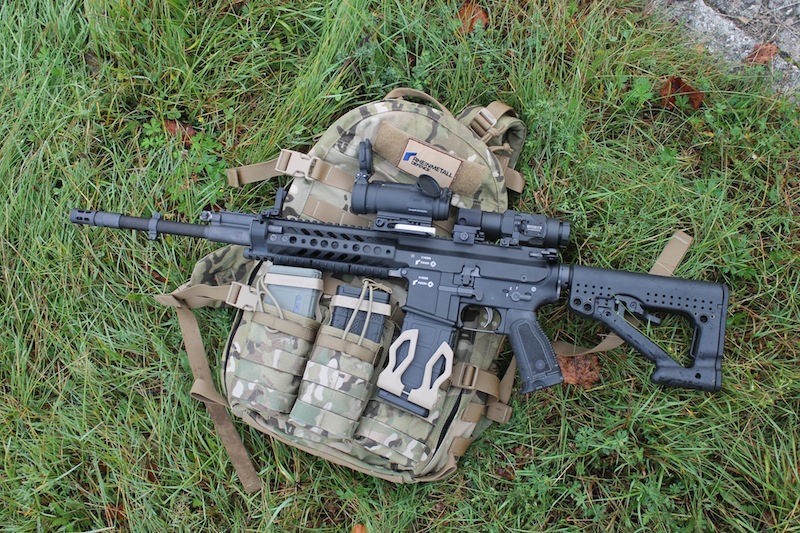 Modulares Sturmgewehr RS556 und Anbau-Granatwerfer RS40: In Unterlüß mit dabei: Das neue Sturmgewehr RS556 von Rheinmetall und Steyr im Kaliber 5.56mm x 45. Diese Waffe auch das nächste Sturmgewehr der Bundeswehr werden. Rheinmetall tritt damit gehen Heckler & Koch an, von denen das aktuelle G36 stammt, das abgelöst werden soll. Mit dem österrechischen Kooperationspartner Steyr hat Rheinmetall jene Firma als Partner, deren Sturmgewehr AUG letzthin den Bewerb gegen das G36 knapp verloren hatte.
Modulares Sturmgewehr RS556 und Anbau-Granatwerfer RS40: In Unterlüß mit dabei: Das neue Sturmgewehr RS556 von Rheinmetall und Steyr im Kaliber 5.56mm x 45. Diese Waffe auch das nächste Sturmgewehr der Bundeswehr werden. Rheinmetall tritt damit gehen Heckler & Koch an, von denen das aktuelle G36 stammt, das abgelöst werden soll. Mit dem österrechischen Kooperationspartner Steyr hat Rheinmetall jene Firma als Partner, deren Sturmgewehr AUG letzthin den Bewerb gegen das G36 knapp verloren hatte. 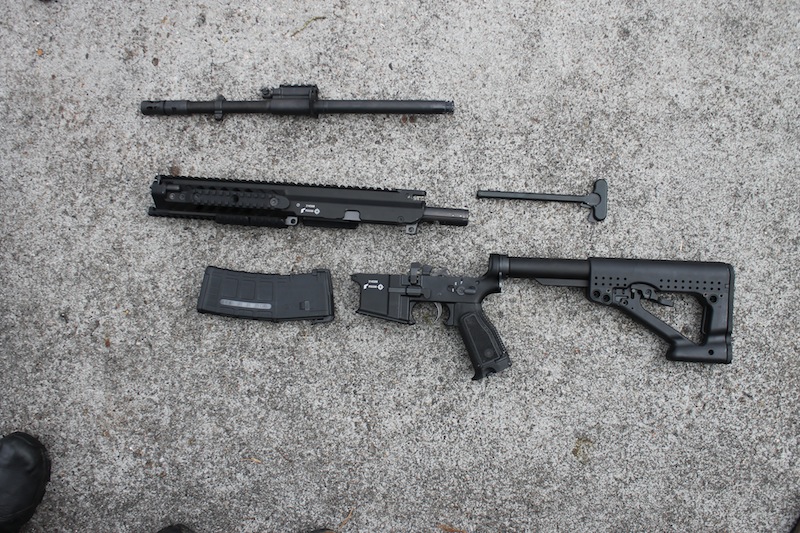 Das RS556 ist ein spannender Verschnitt aus AR15 und AUG: Wir hatten das RS556 „hands on“ in Unterlüß – ein AR15 auf dem technischen Niveau österreichisch-deutscher Ingenieure. Crisp im Schuss, robust und ohne Hemmungen, schmal und führig im Griff, mit den Laufvorteilen, die schon das AUG bietet: einmal entriegeln, drehen und heraußen ist das ganze Teil. Ideal zum Putzen, aber auch Läufe mit unterschiedlichen Längen oder mit Suppressor lassen sich so schnell montieren. Hochmodular lässt sich das RS556 ideal in das System Infanterie integrieren. Und vielleicht auch in die Bundeswehr …
Das RS556 ist ein spannender Verschnitt aus AR15 und AUG: Wir hatten das RS556 „hands on“ in Unterlüß – ein AR15 auf dem technischen Niveau österreichisch-deutscher Ingenieure. Crisp im Schuss, robust und ohne Hemmungen, schmal und führig im Griff, mit den Laufvorteilen, die schon das AUG bietet: einmal entriegeln, drehen und heraußen ist das ganze Teil. Ideal zum Putzen, aber auch Läufe mit unterschiedlichen Längen oder mit Suppressor lassen sich so schnell montieren. Hochmodular lässt sich das RS556 ideal in das System Infanterie integrieren. Und vielleicht auch in die Bundeswehr …  Ein 40mm-Granatwerfer RS40 lässt sich zurüsten oder separat einsetzen. Rheinmetall liefert weiterhin Laser-Licht-Module und Feuerleitvisiere für Handwaffen. Bei den Optiken die entsprechen Flexibilität, die eine Picantinny-Rail bietet: man kann nehmen, was das Beste für den Einsatz ist. Bein Rheinmetall wünscht man sich eine Hensoldt 4x Optik mit aufgesetztem Z-Point.
Ein 40mm-Granatwerfer RS40 lässt sich zurüsten oder separat einsetzen. Rheinmetall liefert weiterhin Laser-Licht-Module und Feuerleitvisiere für Handwaffen. Bei den Optiken die entsprechen Flexibilität, die eine Picantinny-Rail bietet: man kann nehmen, was das Beste für den Einsatz ist. Bein Rheinmetall wünscht man sich eine Hensoldt 4x Optik mit aufgesetztem Z-Point. 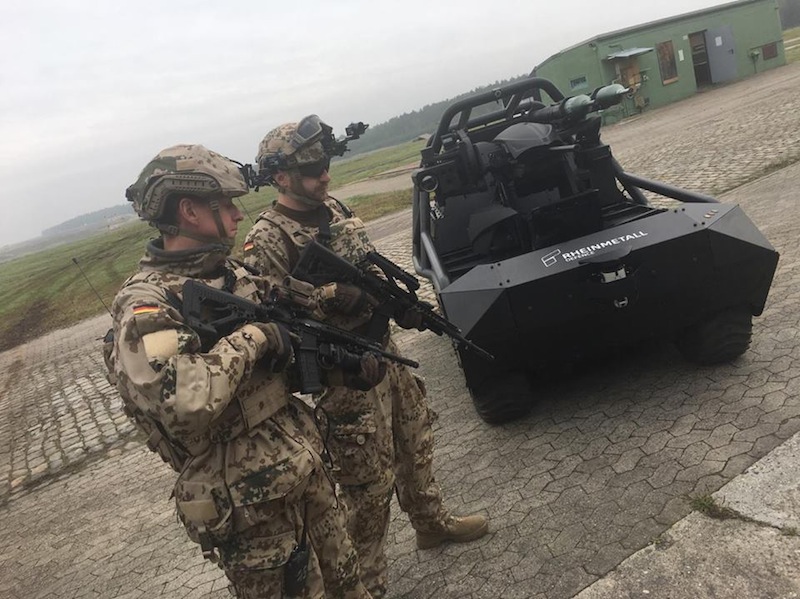 Unbemanntes Mehrzweck-Fahrzeug (UMF): Die Drohne ist nicht nur in der Luft unterwegs, sondern kommt auch begleitend am Boden daher. Unbemannte Systeme in Verbindung mit infanteristischen Komponenten ermöglichen schnelle Aufklärung und Wirkung und unterstützen den Kampf in schwierigem Gelände – sei es in Ortschaften, bewaldetem Gebiet oder im Gebirge.
Unbemanntes Mehrzweck-Fahrzeug (UMF): Die Drohne ist nicht nur in der Luft unterwegs, sondern kommt auch begleitend am Boden daher. Unbemannte Systeme in Verbindung mit infanteristischen Komponenten ermöglichen schnelle Aufklärung und Wirkung und unterstützen den Kampf in schwierigem Gelände – sei es in Ortschaften, bewaldetem Gebiet oder im Gebirge. 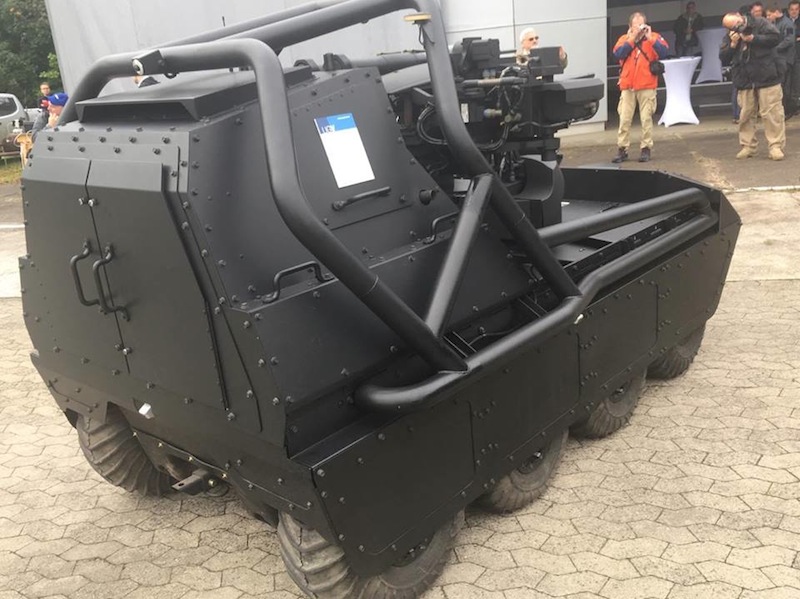 Dort, wo das Risiko für den Infanteristen besonders hoch ist, können unbemannte Systeme effizient Aufgaben des Soldaten übernehmen. Rheinmetalls unbemanntes Mehrzweck-Radfahrzeug ist ebenfalls modulares hochmodular angelegt. Es lässt sich durch die Integration verschiedener Missionsausstattungen für vielseitige Einsatzzwecke nutzen – etwa als Sensorplattform zur Aufklärung und Überwachung, als Waffenträger oder als Transportfahrzeug. Sowohl Fernbedienung als auch autonome Operation sind
Dort, wo das Risiko für den Infanteristen besonders hoch ist, können unbemannte Systeme effizient Aufgaben des Soldaten übernehmen. Rheinmetalls unbemanntes Mehrzweck-Radfahrzeug ist ebenfalls modulares hochmodular angelegt. Es lässt sich durch die Integration verschiedener Missionsausstattungen für vielseitige Einsatzzwecke nutzen – etwa als Sensorplattform zur Aufklärung und Überwachung, als Waffenträger oder als Transportfahrzeug. Sowohl Fernbedienung als auch autonome Operation sind
möglich. Es kommt auf kompakten Rädern daher und wirkt wie ein überdimensiertes Quad – es soll auch mit Ketten kommen. 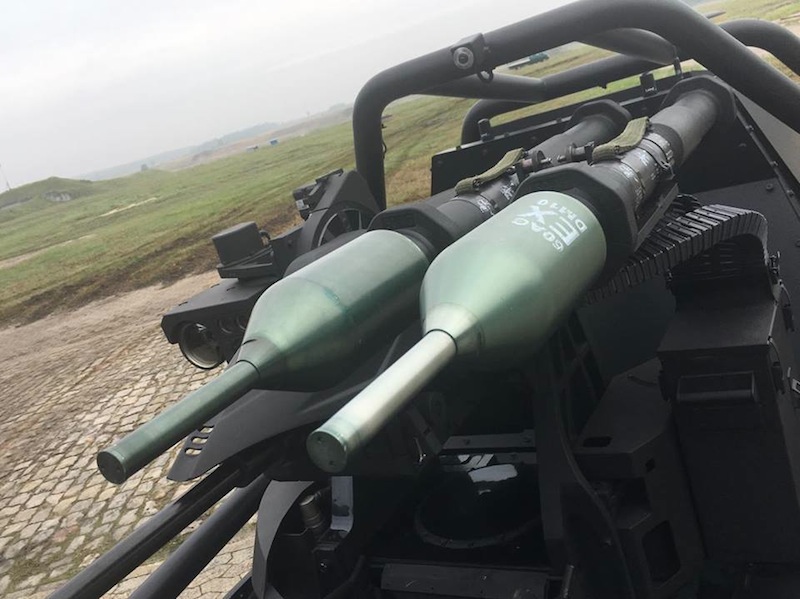 Das gezeigte Modell glänzt mit einer furchterregenden Ausstattung mit .50 Maschinengewehr, dazu zwei Panzerfäuste und die entsprechenden Optiken, um alles zu sehen, was man treffen will.
Das gezeigte Modell glänzt mit einer furchterregenden Ausstattung mit .50 Maschinengewehr, dazu zwei Panzerfäuste und die entsprechenden Optiken, um alles zu sehen, was man treffen will. 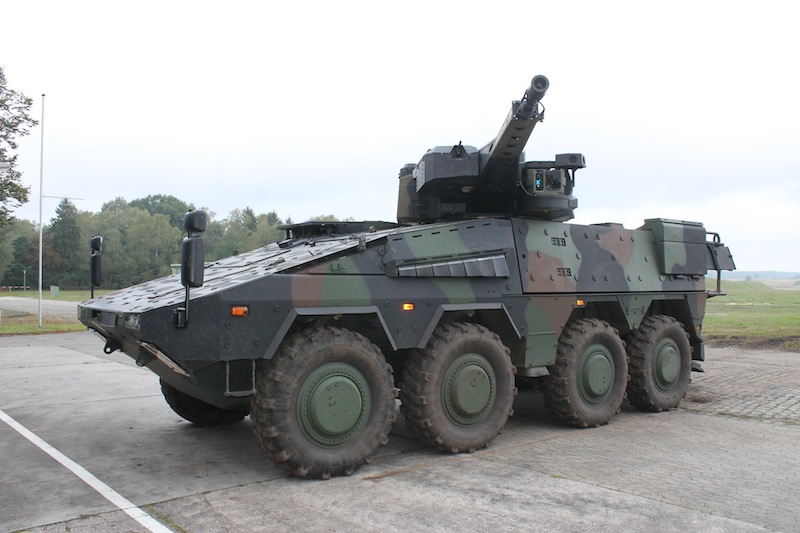 GTK Boxer mit LANCE-Turm: Wie ein Schlachtschiff kreuzt der Radpanzer über die Proving Grounds in Unterlüß, wie Wellen spritzt das Erdreich, wenn er scharf in die Kurve geht, die Kanone konsequent stabilisiert am Ziel. Der Zwei-Mann-Turm LANCE macht die hochmobile, bestens geschützte und einsatzbewährte 8x 8-Fahrzeug zu einem kampfstarken und vielseitigen Gefechtsplattform.
GTK Boxer mit LANCE-Turm: Wie ein Schlachtschiff kreuzt der Radpanzer über die Proving Grounds in Unterlüß, wie Wellen spritzt das Erdreich, wenn er scharf in die Kurve geht, die Kanone konsequent stabilisiert am Ziel. Der Zwei-Mann-Turm LANCE macht die hochmobile, bestens geschützte und einsatzbewährte 8x 8-Fahrzeug zu einem kampfstarken und vielseitigen Gefechtsplattform.
LANCE bietet mit seiner modernen Sensorik und airburstfähiger 30mm Maschinenkanone MK30-2/ABM hohe Wirksamkeit inklusive Hunter-Killer Fähigkeit, sowie die Möglichkeit der Beobachtung und Führung des Gefechts über Luke. Weiterhin erleichtert der bemannte Turm insbesondere in schwierigem Terrain die Führung des Fahrzeuges sowie die Verbindung zu den infanteristischen Kräften. Darüber hinaus ist es möglich, Störungen an der Waffenanlage unter Panzerschutz zu beheben.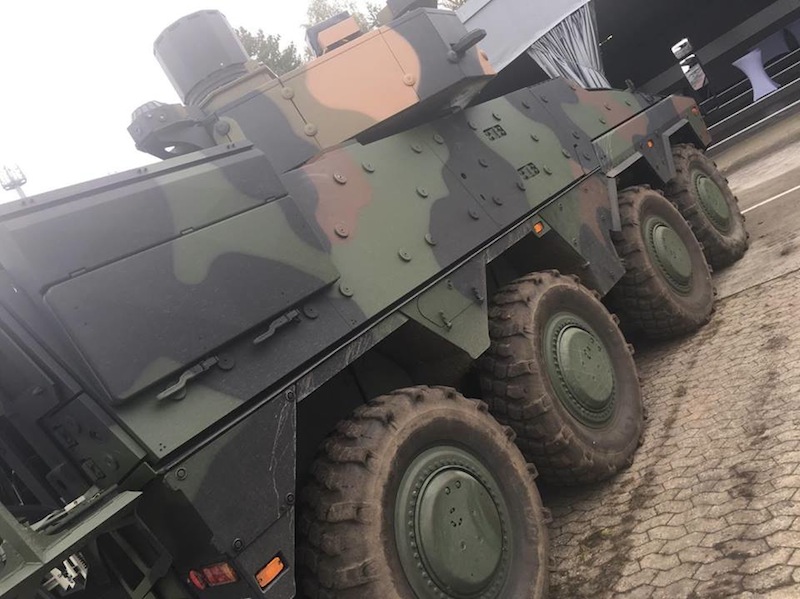 Insgesamt in beeindruckener Einblick in die Möglichkeiten moderner Gefechtsführung. High-Tech wird zu einer Brücke, die verschiedenste Möglichkeiten zusammenführt: Rheinmetall kann darüber hinaus weitere Komponenten und Systeme in sein „System Infanterie“ und sein „System Panzergrenadier“ einbinden und so maßgeschneiderte, flexible, ganzheitliche und zukunftsfähige Lösungen anbieten. In allen Ländern wird am „Soldaten der Zukunft“ geforscht. Hier ist ein extrem fortschrittliches System für die Infanterie bereits Wirklichkeit geworden.
Insgesamt in beeindruckener Einblick in die Möglichkeiten moderner Gefechtsführung. High-Tech wird zu einer Brücke, die verschiedenste Möglichkeiten zusammenführt: Rheinmetall kann darüber hinaus weitere Komponenten und Systeme in sein „System Infanterie“ und sein „System Panzergrenadier“ einbinden und so maßgeschneiderte, flexible, ganzheitliche und zukunftsfähige Lösungen anbieten. In allen Ländern wird am „Soldaten der Zukunft“ geforscht. Hier ist ein extrem fortschrittliches System für die Infanterie bereits Wirklichkeit geworden.
Rheinmetall Defence im Internet: http://rheinmetall-defence.com
SPARTANAT ist das Online-Magazin für Military News, Tactical Life, Gear & Reviews.
Schickt uns eure News: [email protected]
Werbung
Hol Dir den wöchentlichen SPARTANAT-Newsletter.
Dein Bonus: das gratis E-Book von SPARTANAT.


